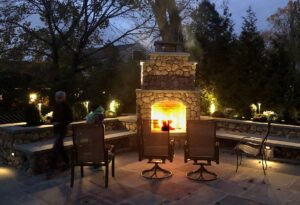![]() Among the most basic elements architects have to design with are: Space and Light.
Among the most basic elements architects have to design with are: Space and Light.
As Lao Tzu said “The utility of the cup comes from the emptiness of the vessel”.
S P A C E
We know that uncomfortable feeling of a person standing a bit too close and wish they would scooch over or the space we wish were smaller when an empty parking lot can feel somewhat spooky. Humans have senses that are still very primal- our vision, our hearing help govern our feeling of proximal distance that feels comfortable -or not. As do cultural norm:s where standing in line in Nanjing is a mind-bending episode for many westerners.
So as an interesting trial, notice the next times you are in social situations and observe the distances that people keep from one another and note their relationships…2 person, 3-persons, groups. The maximum diameter of the group is usually 8′-10′. This has to do with the normal range of conversation and also the visual ability of humans to fully judge facial expressions. Even in hotel lobbies, seating is accordingly clustered in groups, and you can see it in action. In eastern cultures, (from my experience) it is “normal” to stand or be seated about one-third closer that we’ll see in NYC….it takes some getting used to.
Notice how speed and tasks affect the perception of space. 35 miles per hour on certain roads feels slow, but too fast in a parking lot.
L I G H T
Is a powerful tool in the designers tool-kit. Light’s ability to make space , walls, people, textures and color appear beautiful or bland is well understood. Brightness, color rendition and beam spread are critical for illumination.

Intensity and brightness is critical for reading , even more so for surgery and examination. But take your go-to romantic restaurant for an anniversary with bright lighting and it feels in-congruent, Brightness is measured in foot-candles or lux, Most light-bulbs are labeled accordingly.
Lighting levels should be designed in relation to the tasks at hand : partly for human comfort, efficacy and of course for energy conservation.
| ROOM TYPE | LIGHT LEVEL (FOOT CANDLES) | LIGHT LEVEL (LUX) |
|---|
| Bedroom – Dormitory | 20-30 FC | 200-300 lux | |
| Cafeteria – Eating | 20-30 FC | 200-300 lux | |
| Classroom – General | 30-50 FC | 300-500 lux | |
| Conference Room | 30-50 FC | 300-500 lux | |
| Corridor | 5-10 FC | 50-100 lux | |
| Exhibit Space | 30-50 FC | 300-500 lux | |
| Gymnasium – Exercise / Workout | 20-30 FC | 200-300 lux | |
| Gymnasium – Sports / Games | 30-50 FC | 300-500 lux | |
| Kitchen / Food Prep | 30-75 FC | 300-750 lux | |
| Laboratory (Classroom) | 50-75 FC | 500-750 lux | |
| Laboratory (Professional) | 75-120 FC | 750-1200 lux | |
| Library – Stacks | 20-50 FC | 200-500 lux |
Color of the light (or sky) plays a major factor in our ability to read the correct color We’ve all tried to find our car in an old parking lot with the mercury vapor lights, the ones that renders color so poorly that we have difficulty finding our car. We also know the soft seductive glow of a candle and camp-fire with the warm glow and flickering intensity that signals intimacy. The “color” rendition of the light bulb or lamp as it is called in the trade is measured through various scales (CRI, Kevin, Stokes etc) , some produce a warmer , some cooler tones which can be appropriate for different purposes, materials and situations.
| amp Color Name | Apparent Color Temperature (Kelvin) | Characteristics and Examples | Common Adjectives Used to Describe the Light | Best Location |
| Warm White | 2700-3200K | Similar to incandescent bulb, yellowish light is best for accentuating skin tones and color of wooden objects | Friendly, warm, inviting, intimate, relaxing | Homes, boutiques, reception areas, Hotels. |
| Natural White | 4000-4500K | Similar to early morning sunlight, Xenon lamp for automotive use | Neat and clean, Natural tone | Offices, School Lights, Outdoor Areas |
| Day White | 5500-6000K | Typical day light, Flash light. Metal Halide | Crisp light, efficient, brightly lit, natural outdoor | Retail stores, Factories, Printing, Warehouses, Schools, Parking Lots, Outdoor Area Lighting |
| Cool White | 7000-7500K | Best contrast but least flattering to the skin, may need mixing with light from a warm white lamp. | Bright light, bluish light | Special applications needing high light intensity and good color rendition like art Galleries, museums, showcases for precious stones and jewelry |
Also beam spread and proximity of light-source are factors we all know from the classic” detective interviewing the perp” with the flash-light 2′ from the perp’s face and opposite situation were we are trying to read the medicines’ instructions on the bottle printed in tiny print and a light source -too far away. Not good for sure.



